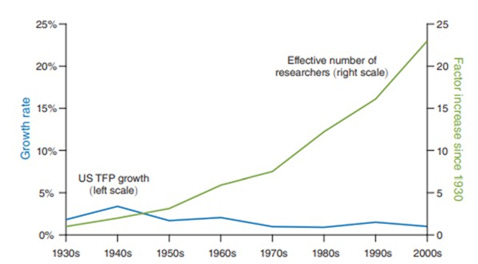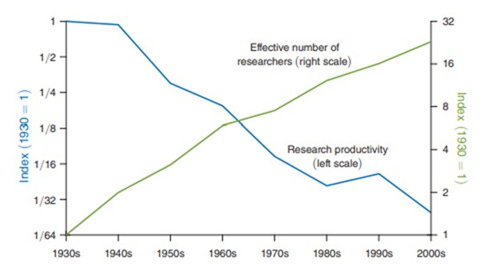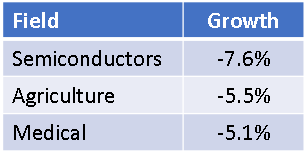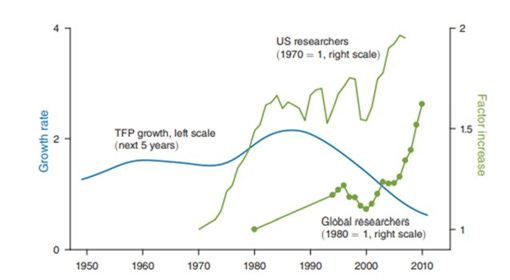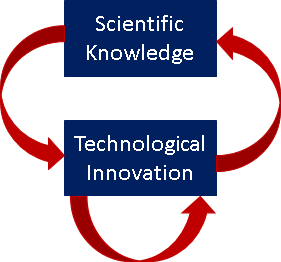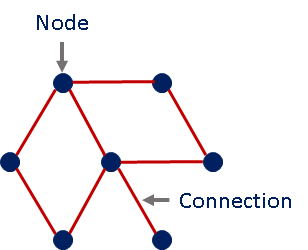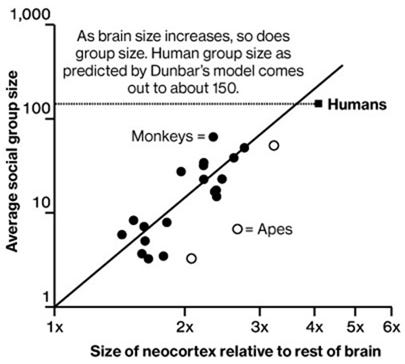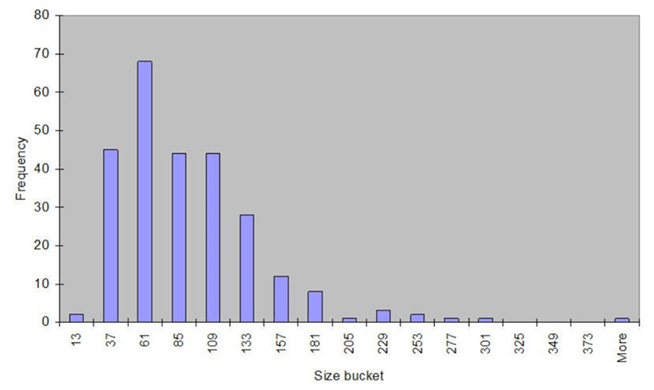Technological Innovation
Productivity growth is dependent on progress in science and technology, both of which exhibit diminishing returns, making high growth rates unlikely.
Productivity growth is driven by technological innovation, which in turn is at least partly dependent on scientific knowledge. The feasibility of an increase in economic growth therefore depends on innovation and knowledge. While it has been suggested that both of these are increasing, it also appears that returns on investments in these areas are decreasing. Significant increases in economic growth appear unlikely given the inherent difficulty of increasing knowledge when there are decreasing returns.
Science
Our ability to understand physical phenomena determines our ability to utilize those phenomena in technology. As scientific knowledge increases, the scope of potential technologies increases along with it, although the commercial value of new scientific knowledge varies significantly and the time delay between when a concept is understood and when it can be effectively utilized can be large. For example, the theories around quantum mechanics were largely developed in the 1920s and 100 years later this could have an enormous impact through the advent of quantum computing. The structure of DNA was first determined in the 1950s and even today the full promise of biotechnology is not even close to being reached. While technological innovations and in particular commercial applications generally follow scientific understanding, it can also be the case that a physical phenomenon is utilized before it is fully understood, like electromagnetism. Information technology creates the potential for significant innovation without requiring advances in traditional fields of science, but this is a unique situation. Continued advances in scientific knowledge and better utilization of existing knowledge will be required to drive technological innovation in most fields.
Normal Science and Paradigm Shifts
Thomas Kuhn argued that mature sciences operate within a scientific paradigm that emerges out of the classic research exemplars within a domain. Normal science is the day‐to‐day research that scientists conduct in order to fill the gaps in scientific knowledge that are found within the dominant paradigm. Kuhn argued that paradigms always have intractable problems that result in research anomalies. Findings emerge that the paradigm cannot explain, decreasing the scientific community's confidence in the paradigm and at some point scientists will begin operating outside of the dominant paradigm in an attempt to resolve these anomalous results. Eventually the dominant paradigm may shift in what is referred to by Kuhn as a scientific revolution. This can cause the development of scientific knowledge to appear lumpy, with long periods where apparently little changes followed by relatively short periods where a large shift in understanding occurs. This can make it difficult to assess progress in science, as from the perspective of an outsider, only the paradigm shifts are likely to appear important. Examples of paradigm shifts include:
Copernican cosmology (heliocentrism)
Classical mechanics (Newtonian mechanics)
Darwin’s natural selection
Quantum mechanics
General relativity (Einstein)
The Limits of Science
At some point there is likely to be a limit on scientific knowledge or at least a limit on our ability to continue expanding our knowledge. While I am not suggesting we are at or even approaching this point yet, it appears that there are diminishing returns on investments in gaining scientific knowledge which are likely to act as a significant drag in coming decades. This should be expected as scientists are likely to pick the low hanging fruit initially, making further advances increasingly difficult to achieve.
Growth in knowledge is the result of the productivity of researchers and the number of researchers working in a particular field. Investment in science continues to grow, as has the number of researchers, but the returns on these investments are declining, as is the productivity of researchers. A contributing factor to this could be the declining utility of having more researchers on a project. As science advances, scientists also have to spend increasingly large proportions of their career studying to reach the boundary of knowledge before they can advance that boundary. This is evidenced by the fact that Nobel Prize winners are becoming older when they complete their award winning work and the fact that the age at which inventors file their first patent is increasing.
Figure 1: Total Factor Productivity Growth and Research Effort (source: Stanford)
Figure 2: Research Productivity (source: Stanford)
The productivity of research has been declining across a range of fields in recent decades and as a result an increasingly large number of researchers have been driving stagnant or declining growth.
Table 1: Research Productivity Growth 1970-2009 (source: Stanford)
Figure 3: Total Factor Productivity Growth and Research Effort in Agriculture (source: Stanford)
Technology
Technology is the entire collection of devices and engineering practices available to a culture. Scientific knowledge provides a basis for technological innovation and in turn advances in technology can be used to expand scientific knowledge. New technologies are also constructed from existing technologies in a combinatorial fashion. For example, the smartphone was largely developed out of existing technologies (GPS, microprocessors, LEDs, etc.).
Figure 4: The Relationship Between Scientific Knowledge and Technological Innovation
There have been a large number of innovations over the course of human history which have allowed society to reach its current point. The significance of these vary, with some having a fairly transient, localized or narrow impact, while others have had a widespread and long-term impact, including:
Fire
Language
Social Structures
Flora Domestication
Fauna Domestication
Buildings
Wheels
Money
Turbines
Ships
Plumbing
Steam Engine
Factory System
Railways
Telegraph
Internal combustion engine
Telephone
Automobile
Electricity
Airplane
Chemical Engineering
Computers
Internet
Biotechnology
In coming decades the following technologies have the potential to create similarly large impacts:
Robotics
Artificial Intelligence
Nanotechnology
Blockchain
Quantum Computing
Combinatorial Innovation
Existing technology can be considered a knowledge base from which new technologies can be developed. As the size of this knowledge base grows, so does the potential for new technologies through combinatorial innovation. This is similar to a network effect, allowing the value of the knowledge base to be assessed using a Metcalfe’s Law type relationship.
The value of the knowledge base will be dependent on the number of nodes, the number of connections between those nodes and how valuable the connection between each node is. Assuming that every node is related to every other node in some way and that the connections all have the same value leads to Metcalfe’s Law:
Equation 1: Network Value Based on Metcalfe’s Law
If some technologies are unrelated to others, then there would be no connection between nodes, leading to a more sparsely connected network. A more sparsely connected network can be valued based on Zipf’s Law:
Equation 2: Network Value Based on Zipf’s Law
Zipf’s Law is an observation that for many types of data the rank-frequency distribution is an inverse relationship. For a network with n members, the value of connections will be proportional to 1 + 1/2 + 1/3 +… + 1/( n –1), which approaches log( n ).
Figure 5: Example of a Sparsely Connected Network
Using this approach, the growth in the value of knowledge based on past technological innovations provides a reasonable approximation for observed productivity growth, assuming a lag between innovations and their impact of approximately 35 years. Extrapolating the current pace of innovation points towards continued weak productivity growth. If the pace of technological innovation were to accelerate dramatically, productivity growth would follow but in realistic scenarios would still only be in the low double digits.
Figure 6: Knowledge Growth and Productivity Growth (source: The Federal Reserve)
Scale
It has been argued that the nature of an organism (including companies and cities) determines how it behaves as it scales. Companies and living organisms have hierarchical and centralized structures and as a result exhibit diminishing returns to scale and have limited size and lifespan. In comparison cities have a decentralized structure and exhibit constant or increasing returns to scale and have potentially unlimited size and lifespan.
Considering knowledge under the same framework, it would be hierarchical and relatively centralized. This is not because knowledge is centrally controlled but because developing new knowledge requires a person to first learn the relevant existing knowledge. As the knowledge base grows it becomes increasingly difficult to connect different pieces of knowledge and understand how they relate. It also becomes increasingly difficult for any one individual to have sufficient understanding (breadth and / or depth) of existing knowledge. As a result, diminishing returns on developing knowledge and increasing research team sizes should be expected.
Dunbar’s Number
Expansion of the number of researchers working on the same problem likely introduces diminishing returns due to the inherent difficulty of a large group of people working together effectively. Robin Dunbar noted that there appears to be a cognitive limit on the number of people (~150) with whom one can maintain stable social relationships. For a group of this size to remain cohesive, as much as 42% of the group's time would have to be devoted to social grooming. Correspondingly, only groups under intense survival pressure have maintained 150 members. Such groups are also almost always physically close. In dispersed societies, social relations will be more difficult to maintain and as a result groups will generally be smaller.
Figure 7: Maximum Social Group Size Based on Neocortex Size (source: barriebramley)
This observation also applies to the size of effective teams, although the optimal size for technical groups is estimated to be around 45-50. More than this and a group spends excessive time on maintaining cohesion rather than focusing on the task at hand. This can be seen in data from online games where cohesive group sizes generally range from 35-110.
Figure 8: Ultima Online Guild Size Distribution (source: lifewithalacrity)
Conclusion
Scientific knowledge drives our ability to develop new technologies. As the scientific knowledge base grows, so does the potential for new technologies. Growth in scientific knowledge can be lumpy though with periods of normal science where little progress appears to be made, followed by paradigm shifts where a rapid change in understanding occurs. There are likely diminishing returns on our ability to generate scientific knowledge though, meaning an increasingly large amount of resources will need to be devoted to research to gain diminishing amounts of knowledge.
Technological innovation begets technological innovation as each new technology can act as a modular building block for further innovation. Technology is like a knowledge network where the value is proportional to the relationship between the nodes. As the knowledge base grows there are diminishing returns to new knowledge though, particularly if new knowledge only relates to a small amount of the existing knowledge base. The most value is derived from general purpose technologies which can underpin a broad range of new technologies. This implies that to achieve constant growth, an accelerating pace of innovation is needed.
Science and technological innovation exhibit diseconomies of scale, a common phenomena in centralized and hierarchical systems. This likely has a number of causes, one of which is the difficulty of coordinating and maintaining cohesion in large groups. Humans have limited cognitive ability to create and maintain relationships with other humans and as the working size of a group grows, people must dedicate an increasingly large amount of their time to social relationships, detracting from productivity. This limits progress in science and technology, where large groups are a necessity due to the broad and deep knowledge requirements of the work.
Rather than innovation accelerating it is probably more reasonable to expect that across most areas of the economy, innovation will continue to stagnate. The value of existing scientific and technological knowledge will likely grow at a diminishing pace and this growth will require greater resource commitments.



